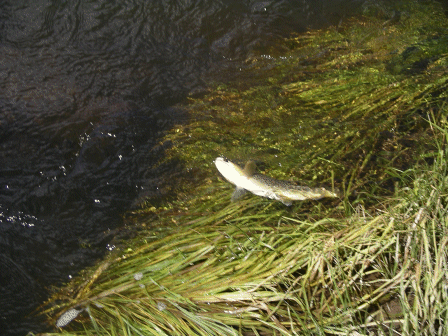
July, 2005
07/1-2: Against my better judgment I deferred to Sue's request to do a couple of days fishing at the start of the 4th of July weekend. Colorado's mountains are absolutely slammed with people on this holiday, and personally I'd rather hibernate in the condo for the four days rather than risk driving our roads and fighting the crowds.
As she'd not seen some of the water I'd fished the previous couple of days, we decided to basically revisit those places and see if we could repeat some of the modest success enjoyed earlier in the week. Took off in the Eurovan early Friday morning, drove to Silverthorne, then up & over Ute Pass and arrived at the inlet to Williams Fork reservoir around 10 in the morning. Hiked down to the same stretch of shoreline where I'd had decent success on pike earlier in the week and began casting with streamers. I had zero success - not even a strike. Sue had two or three hits, but after an hour & a half of no luck, we packed back up & headed through Granby & up into Rocky Mountain Park.

Stopped a bit further upstream where the flows were somewhat lower than the last trip and found very tough going. I advised using a very heavily weighted wooly bugger to try to get close to the bottom in some deeper eddies, but it really didn't avail us much. I caught a couple of small browns & brookies and Sue had no strikes at all.
Did manage to get a shot of a massive bull elk that was grazing next to us in
a meadow, but that was about the extent of the excitement for the first stop.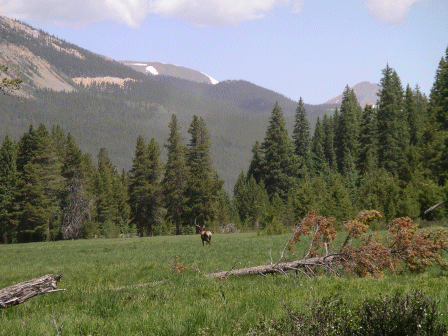
Downstream where I'd had some better luck earlier in the week, today was basically a complete bust. Again caught a couple of small brooks but the water's still really running too swiftly to allow proper approaches to the limited number of fish that occupy this part of the stream. It was starting to look like the trip would be a disaster from a fishing standpoint.
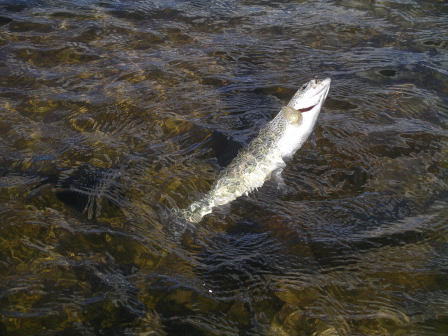
Back to the base of Shadow Mountain Dam we drove, and I'll admit to being completely astonished at the lower water flow being released from the dam. This section of the Colorado River appeared to be running three feet lower in depth along the banks compared to a couple of days ago - and a mere fraction of the 1000 or so c.f.s. that I'd had to contend with on the last trip here.
Just an amazing transformation to the state of this stream in how it could be approached and fished.
Apparently none of the other local fishermen were aware of the change either, so we had a wonderful stretch of boulder strewn pocket water and some nice quiet pools completely to ourselves. The fishing was almost indescribably outstanding.
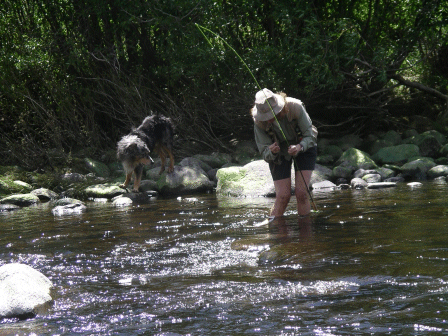
Stream temperature was plenty warm to permit wet wading. A decent caddis hatch was in progress throughout our time on the water - and the fish here were not only willing, but eager to share our flies over and over again. To be honest I don't think either Sue or I have ever had a day like this before in our lives. It was like fishing must have been in the Garden of Eden.
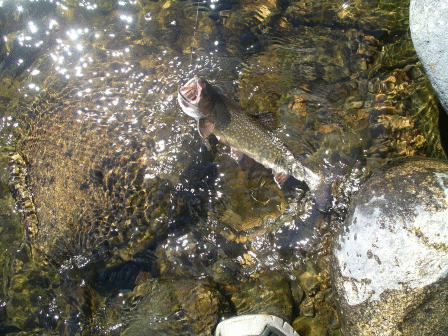
The trout - all four indigenous Colorado species - came to either a surface WRS or a trailed nymph with more or less complete abandon. Best setup seemed to be a #16 on the surface and a #18 or 20 unweighted prince at the tail end.
Both Sue & I grand slammed today - another first for us while fishing together.
Interestingly Colorado cutthroats dominated the catch. Rainbows were next followed by browns and then brooks. Sizes for all species were more than decent. The cuts ran 12-15 inches. Rainbows between 10-18 inches. Ditto for the browns. The brooks seemed to be mostly around a foot in length.
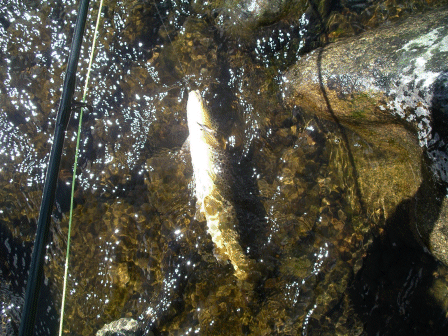
It was so strange to find all these species occupying the same water and in such good sizes with strong, healthy bodies. I still can't get over the quality of the fishing.
It's almost obscene to talk about numbers played & released, but I'd guess that between us it ran into low triple digits this afternoon.
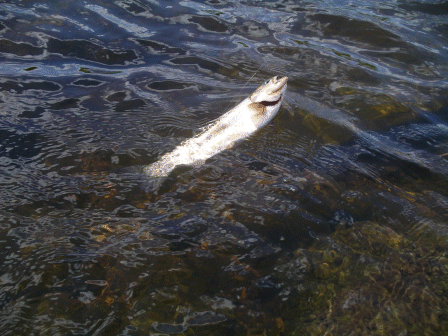 We camped on a back
road off Stillwater Pass and spent a very restless night listening to the
constant stream of traffic moving into the mountains.
We camped on a back
road off Stillwater Pass and spent a very restless night listening to the
constant stream of traffic moving into the mountains.
Over a cup of coffee before breakfast we were salivating thinking about how good the fishing might be further down in the deeper part of the canyon below where we'd spent the prior afternoon. Then we had a wonderful breakfast at Betty's Bakery that qualifies for our a spot on our "good eats" page.
With full tummies we then drove back to the trailhead and began the walk on the trail, but on first noticing the water, lo & behold it was back up to maybe 1000 c.f.s. again. What a disappointment.
We hiked a mile or so downstream anyway but could only find a couple of spots where a fly could be placed in a tiny eddy of holding water. A couple of strikes were all we could muster today.
Started back towards home. Stopped at a popular spot in Hot Sulfur Springs and yanked the bugger along the bank for a few minutes but only picked up a couple of twelve inch browns.
Similar lack of success followed at Williams Fork where this time neither of us had so much as a strike from the resident pike. And then it was back home to a hot shower. Good memories of that trip will remain. Don't know how we'll ever replicate the previous afternoon's extraordinary results as there's no flow guide specifically for the stretch on the Colorado stream flow site. Such is life.
7/6: On the monthly trip to Eagle to pick up some real estate data I took a few minutes to try to fish that river just upstream of the town and had no luck. Used a black rabbit bugger & tried to slap it along the bank in a couple of spots, but casting was virtually impossible due to the high water and close proximity of the bankside willows. Did get three strikes but they were more of the annoyance type rather than something finding my fly appealing from a food standpoint. While the Eagle can be fished in places right now, it's really not worth the effort as it cannot be waded due to high flows.
Gore Creek is coming down too, and I'd guess that it should be pretty much wadable everywhere within ten days to two weeks. We'll try a few spots in the Arkansas River valley tomorrow through the weekend.
7/7-9: If nothing else, at least this week's trip can be described as an adventure. And if I never see another jeep road again, it will be way too soon.................but I already know there are more in our future this summer
Sue's chauffeuring her dad on a reunion of some sort to North Dakota, so it was up to the dog & me to keep the fishing spirit alive this week. We headed out early Thursday morning, drove to Leadville and through, and shortly turned off at the upper part of the Hayden Meadows SWA. The water flow there is just about perfect at roughly 100 cubes, but the local browns were surprisingly quiet. It's possible someone had just fished through my favorite stretch, but it took passes at a good eight structures before hooking the first fish. Lots of caddis were in the bushes but at midday they really weren't out on the water.
A #18 dark bodied WRS seemed to do the trick although it wasn't outstanding fishing. Probably played 8-10 fish in the ten to twelve inch range in an hour or so up here. Continued our drive down the Arkansas and noticed big releases coming from Twin Lakes so we passed on some interim stops & headed directly to Buena Vista for our regular hamburger lunch at the drive-in near the park. Gassed up & drove up Cottonwood Creek towards the pass. Had planned on trying a few places on that small stream, but every spot I knew about was already occupied so we continued up & over & down into Taylor Park Did our regular pulloff at the bridge over Willow Creek & caught a few more tiny browns in this little meadow stream.
Then instead of heading directly to the Upper Taylor, I decided to try out a long festering idea about the tailwater below that dam. Parked upstream of the bridge and did the long hike down river left over a talus field and threw a wooly bugger into the faster water below the bridge hole. Zero, zip success. Not a strike. Shifted to a #22 midge larva trailed four feet below a # 18 WRS and came up blank again.
Did the nasty hike back to the bridge & started working my way up the
same side of the river. Not many people were on the water here today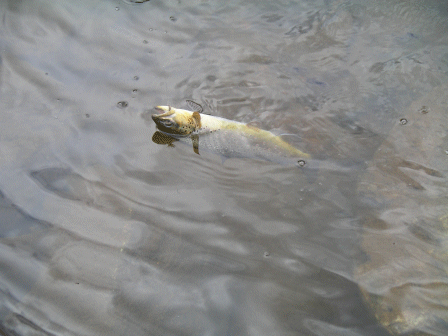 which was a blessing. Combat fishing's not my cup of tea. Anyway,
about a dozen casts later a miracle happened and a fourteen inch brown took the
surface fly. I couldn't believe it. Nothing ever comes to the
surface here. Just a wonderful surprise!
which was a blessing. Combat fishing's not my cup of tea. Anyway,
about a dozen casts later a miracle happened and a fourteen inch brown took the
surface fly. I couldn't believe it. Nothing ever comes to the
surface here. Just a wonderful surprise!
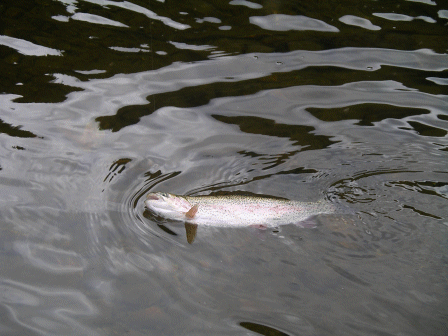 Lengthened the leader
to16 feet and went to 7X at the end with a #20 comparadun and wouldn't you know
it, shortly a sixteen inch rainbow took the fly. That was about it for the
day. Only a few more tentative strikes and one extra twelve inch brown to
hand, but I was pleased as punch. The fishing here is very difficult &
to land three fish - albeit quite small ones - was monumental success for me.
Lengthened the leader
to16 feet and went to 7X at the end with a #20 comparadun and wouldn't you know
it, shortly a sixteen inch rainbow took the fly. That was about it for the
day. Only a few more tentative strikes and one extra twelve inch brown to
hand, but I was pleased as punch. The fishing here is very difficult &
to land three fish - albeit quite small ones - was monumental success for me.
As it was late afternoon, apparently some of the local denizens of the ridges
found us fisher people to be non threatening and a group of maybe ten Rocky
Mountain goats came to the river for watering.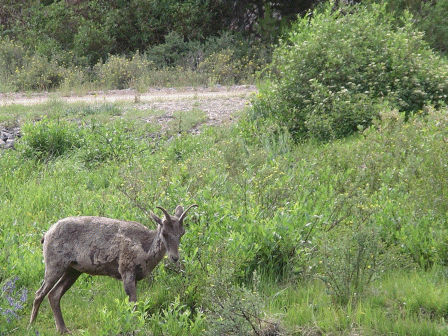
Back upstream we went & drove to a nice camping spot a couple of miles up the inlet stream. Unhappily the wind was shrieking downstream now making casting after dinner very difficult. On a more positive note caddis were everywhere and were ovipositing until 8 at night.
Used a gray #18 WRS on the surface & trailed it with a #18 antenna pupa. Had decent success tonight - probably 20-30 fish - mostly to the surface fly. None were large. One might have stretched to fourteen inches and all were browns which was a disappointment. In past years the catch here has been quite mixed between rainbows & browns, but it looks like WD may have worked its unpleasant magic on this river as well as all over the rest of the state.
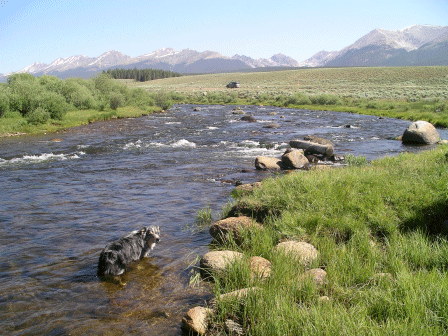
The stream is still flowing strongly enough that it's no fun to wade, but at least these flows allow the fish to spread out a bit and it's a blessing in the long run to the health of the water.
Did a repeat of the same stretch in the morning and then drove upstream and spent another hour. The fishing was great, but again, just for the smallish browns. I'd guess releasing a good 30-40 fish in a couple of hours and probably could have kept this up all day if so inclined. But we had different fish to fry.
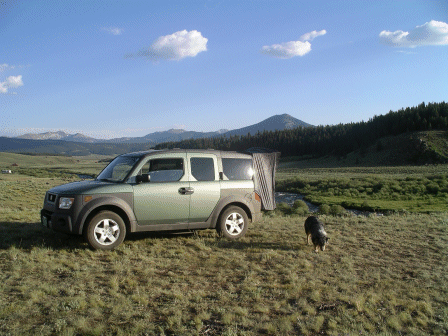
Drove back towards the lake & then up the miserable access road to Texas Creek. Another very pretty meadow stream, but the fish were minuscule even compared to the upper Taylor. Gave up after hooking some of the smallest browns I've ever seen. Can't even bear to report those sizes.
Down to the reservoir we drove & through the gate to the shoreline where Willow Creek enters the lake. Made several casts with a sink tip line & black wooly bugger with no success before noticing some dimples out in front of me and saw several what looked like gray drakes ovipositing on the water.
Couldn't identify the may fly, but put on a #16 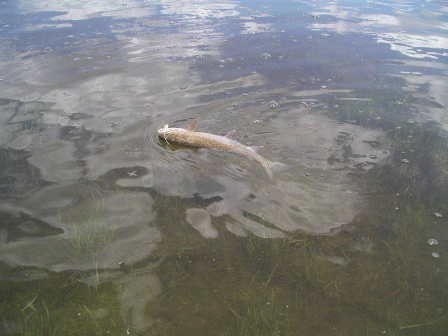 tannish
comparadun and shortly landed a couple of very strong, if not very large,
rainbows. Good fighters. The drakes left the water as quickly as
they had arrived and the surface action stopped.
tannish
comparadun and shortly landed a couple of very strong, if not very large,
rainbows. Good fighters. The drakes left the water as quickly as
they had arrived and the surface action stopped.
Our next plan was to get back over the Continental Divide and fish up the headwaters of Chalk Creek, a major tributary of the Arkansas. On the topo map it appeared that a couple of routes might be possible that would allow us to not have to retrace our steps over Cottonwood Pass and one of those shortcuts might save us 60-70 miles of driving.
The first possibility was Tincup Pass which was up Willow Creek and past
Mirror Lake. It looked like the pass was only twenty miles or so from the
reservoir. So off we went. Into the (semi) ghost town of Tincup
& up the difficult back road to Mirror Lake. The trip got ugly in a
hurry.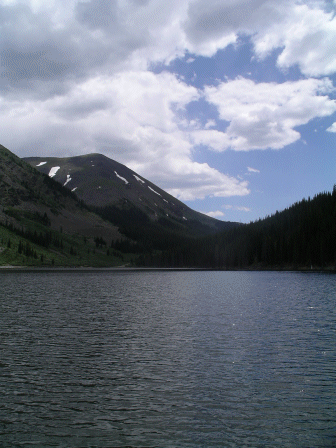
The road's packed with SUV's, ATV's, and dirt bikes. It's very rutted & rocky. Maybe 5-10 m.p.h. max. Got to the lake. Tried a few casts off the shore, but it looks more like a stocked lake set up for wormers - a couple dozen of which lined the banks. No luck for us. Drove up to the start of the road to Tincup Pass, gulped, & turned back. Even though we have an all wheel drive rig, that road clearly needed a real jeep, preferably equipped with winch.
The signage was such that it inferred should you choose to proceed with the wrong vehicle, leave your last will & testament here and your next of kin would be notified in the morning.
Next great idea. Back in Tincup we turned South & headed up & over Cumberland Pass which lead us in the direction of what is known as Alpine Tunnel - which appeared to be another way over the Divide.
This road was better - at the start. While still pretty rocky, we could at least maintain fifteen miles per hour for the next twenty miles and the view from the top of this 12,000 foot pass was absolutely unbelievable. Would have taken photos but had just passed a slow vehicle & didn't want to mess with him again on the descent.
Down into North Quartz Creek drainage we went. Stopped a couple of
times and had nice success on the surface attractor fly, but the little brookies
that took it were really not a lot of fun. Finally found the turn and
started uphill to the Alpine Tunnel, although we had no idea what we were
getting into. Should have known better.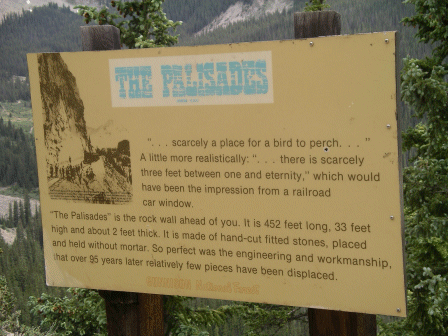
First seven miles of this road follow an extinct railroad bed steeply
uphill. The next three miles were - for me - a living hell.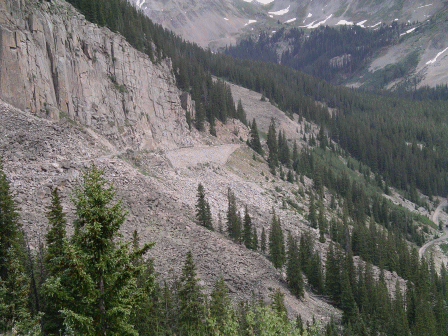
I'm usually pretty aggressive when it comes to back road driving, but these last three miles (see photos) had my knuckles white and throat dry as a bone. Couldn't wait to get to the top & through the tunnel & down into the Chalk Creek Drainage.
You already guessed it. The tunnel is impassable. Apparently the original timbers used to construct it are now so rotted that no one's allowed inside - even on foot. If you think my knuckles got white driving uphill, you should have seen the color going down. Enough said.
OK, now we were really stuck. At the old mining town of Pitkin I had the option of trying some more back roads to get over to the South Arkansas but the thought of another rock in my path gagged me. Took the course of least resistance and drove a nicely paved road all the way back towards Gunnison. Hit Highway 50 and very happily drove all the way East over Monarch Pass and then down to Salida.
It was now 6:00 so we had a quick snack & couple of glasses of wine at the Ouray SWA just across from the smokestack in Salida, then headed down to the river. Lots of flow there and pretty sluggish fish. No sign of a hatch and my small WRS and pupa trailer were soundly rejected. Finally decided to try to hit the fish over the head with something big & ugly so put on a #14 rubber legged WRS and that did the trick - sort of. Released four very strong, but not very large browns in the 12-13 inch range.
We'd planned on camping that night on the road to Hecla Junction but with some sunlight remaining, instead continued our drive to the Chalk Creek turnoff. Got several miles up that stream and "poached" a campsite just before dark.
Next morning it was awake at dawn & up to the "ghost" town of St. Elmo. Had lots of trouble figuring out what to do here. Several strangely marked county & jeep roads lead upstream from the town. I really got lost. The one road we wanted to take that headed up this side of Tincup Pass looked so bad that we passed - even though the North Fork of Chalk is supposed hold some nice sized cuts. Tried the road up towards Hancock Pass which followed the main stem of the stream and that road too got worse quickly than I wanted to deal with, so I gave up & drove back to town. Made some casts in the stream right in town & released a handful of small browns again. God I'm sick of these small browns! Please bring rainbows back - please someone.
Anyway we fished Chalk in a couple more places and caught a few more of these little browns before giving up and driving back to Buena Vista to fuel up the rig. Planned to try our favorite stretch of River Park here, but some kind of white water festival was in progress and we couldn't even drive down main street.
Off we went again to one of the sections of the Arkansas in Granite that we like. Fished it hard along the shore with caddis up & down, but with no sign of bugs on the bankside willows, the fish were modestly interested at best.
Next (and last) stop was on the Ark. just below the Twin Lakes turnoff. Again the fish were unimpressed with my offerings for the first half mile of casting, but as I got up to the railway bridge, had probably a good dozen strikes in that many casts. Don't know what triggered those final better results unless it was the thunderstorm that blew us off the river and on to the highway home in the next few minutes.
7/12: Amazingly, today was the first outing on Gore Creek this year. This for a stream, part of which is no more than 50 yards from my condo. Flow is now dropping fairly rapidly and it can be waded in most places although with some difficulty. Put the rod on the bike & peddled out just East of town & started casting in some likely runs and pools.
Given the relatively strong flows, I'd have been much better off sticking to nymphs exclusively as the trout are still sticking close to the bottom, particularly on a very bright, clear day like today. Used a #18 brown WRS trailed a couple feet by one of those antenna pupas & suspect it was as good a searching setup as could be found since there were no hatches going on & no fish testing the surface.
Eventually started getting a few strikes along the banks where the fish had been driven by the quicker flows. They initially didn't seem to differentiate between the caddis sitting on top versus the one trying to get there so it was pleasant casting. Interestingly brooks dominated the early fishing, and I found that fact somewhat surprising since it's usually mostly rainbows followed by browns, etc. Sizes were nothing to shout about being in the 8-12 inch range, but one was a brook slightly above the norm - and eventually one ten inch brown which got us three legs of the slam.
Kept popping up & down the bank for a mile or so and had decent success everywhere but at a pool we call "nevermiss". It was a bust today for the first time in my memory. Anyway a good time was had and perhaps tomorrow we'll take a quick look at the Eagle down by Dowd Junction.
7/13: The Eagle above Dowd Junction is still flowing too strongly for comfortable wading. I managed to get out in the middle of some pocket water for a few casts but it was a cold cajones tiptoe to get there. My reaction time to the relatively few brown trout strikes I got today was truly miserable. In fact at one point I counted nine in a row without a hookup. Admittedly it was all off handed casting and several casts involved hanging on to a willow with one hand while trying to control the rod with only the other one, but I wasn't a good fisherman this afternoon.
Eventually I played three or four small browns that mostly took the surface WRS. A few caddis are in the bushes next to the bank, but with clear skies and too hot air temperatures, I'd suspect the fish don't really become active until just before dark.
The flows continue to be amazing. Now I'd guess that it will be around the first of August until things settle down to normal summer levels. Good for the fish.
7/16: In an effort to avoid the heavy summer weekend crowds that swarm to the mountains, Sue & I chose to head to the Upper Piney River and do our annual hike downstream to some favorite beaver ponds.
We ran into a few like minded souls on the trail, but for the most part we had no competition for water on this nice little stream. Flowing about 90 cubes at the mouth, this river is probably at an optimum level right now. There's enough water to allow fish to spread out in to riffles and other spots where flows much below this number would not allow them to rest.

We stopped at the big flat around 2 1/2 miles from the trailhead and cast to rising fish for a half hour or so. I landed a couple of smallish browns and missed a number of strikes as did Sue.
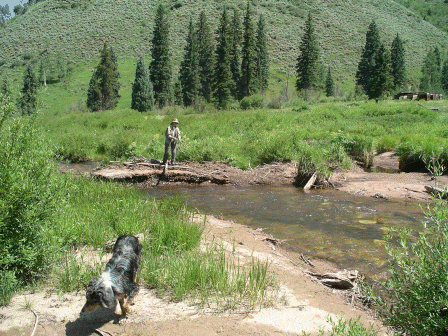
Once we got a bit further down by the ruins of a trapper's cabin the fishing improved dramatically. We worked all the small braids and remains of a large beaver pond that had broken due to this year's strong runoff. Virtually every tiny segment of holding water contained fish.
It was wonderful having these quite innocent trout slam both surface WRS and
trailing pupa with more or less complete abandon. As she said, it was no
skill involved kind of fishing. The only problem of any sort was to avoid
tangling flies in the willows behind and over the places the fish were holding.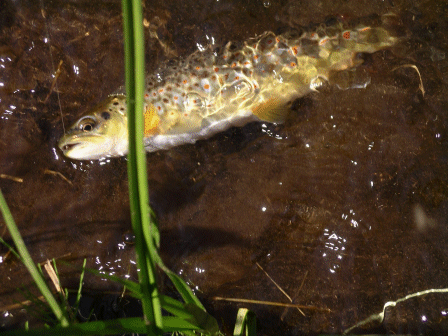
I tried to lure a couple of fish which were clearly rainbows out from their cover but had no luck in that regard. All of our catch were either browns or brooks. We saw no cutthroats at all and while we probably had a rainbow or two strike, neither of us landed any of that species either. Sizes were pretty small as would be expected on this type of high mountain stream with a couple of the browns and one brook topping out at a dozen inches.
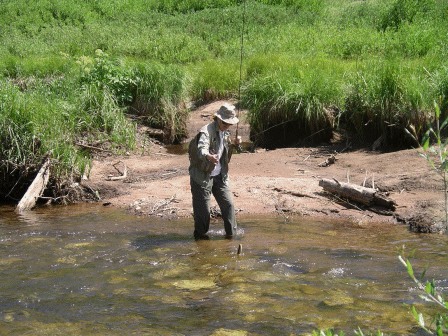
Larger fish certainly live here as we can attest from earlier trips, but it takes dredging the bottom of the deeper holes to have a chance at them, and we had far too much fun playing on and closer to the surface today to work that hard for something only a few inches longer.
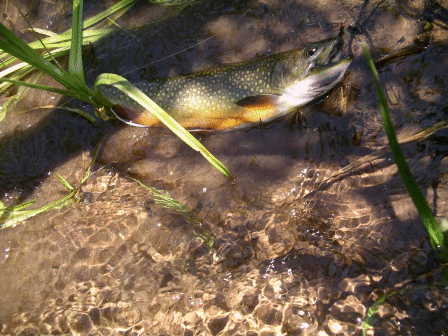
The only issue on this river right now - and it is a big one - is the presence of hoards of deer flies. So despite temperatures in the 80's, both of us put on long sleeved shirts and pants. None of our repellents did the slightest in stopping these biting flies, so the visitor to the Piney will be well advised to cover themselves as completely as possible.
7/21-23: Our ferociously hot July weather continues, but so do the unusually high flows in our local streams. With some loose time on my hands, I volunteered to drive to Sue's Glenwood condo complex and re-stripe the parking lot prior to our heading out on a trip to the Gunnison on Friday. Arrived late Wednesday afternoon and had an opportunity to pop down on the Roaring Fork after dinner for a couple hours of casting.
That river is still basically not easily wadable which seems amazing given how late it is in the summer. But even the 1700 cubes at which it's currently flowing is not an abnormally high rate when compared with the last 97 summers as shown on the governments' water flow site. We've just been spoiled by earlier access in recent years because of our drought situation.
I thought the local browns that populate the stretch below the Sunlight Bridge would be packed along the banks, making them more accessible to a surface fly in the shallower waters but that seemed to not be the case. Either that or I simply made a lousy choice of patterns today. In any case I had decent numbers of strikes to the #18 WRS, but most fish were of the smaller variety. Eventually did hook and play a handful of browns between 10-14 inches although it was relatively disappointing fishing. Nothing took the trailed pupa which seemed out of the ordinary too as there were fair numbers of caddis in the bushes. A stray yellow sally was about the only other kind of bug about - no sign of green drakes.
Finished my striping project by ten the next morning so headed upstream with the dog looking for some better fishing. Drove by Westbank Ranch and into the parking area for the public area just below Aspen Glen. Water is still way too high making for very limited places where a cast can even be placed. Just had lousy success through most of the water using a variety of stones, caddis's, etc. Finally landed a couple of small browns on a pupa near the bank and then had on a wonderfully sized brown of perhaps 20 inches that took the rubber legged WRS in a mid stream eddy.
The fish was unstoppable in the difficult current, got into my backing & eventually pulled free when I put on too much pressure.
Drove just above Aspen Glen and tried walking to the river on that public easement. Walked a good quarter mile of the property before giving up as the flow was so far up the bank that we simply couldn't access the water at any point. Considered trying some of the Crystal but after looking at its flow where it joined the Fork, concluded that idea was also a loser.
Then continued on up Highway 82 to Basalt and the Frying Pan. The stream is truly slammed with other fishermen and hoards of guides which is understandable given how non tailwater rivers are flowing. Found only a couple of places to try my hand as virtually the entire river was already occupied by other bodies. The fishing in that first pool was terrific however. It took a while to figure out which pattern to use as there were numbers of different insects active over the water.
Finally changed to a couple of varieties of PMD's and that pretty much did the trick. A loop wing model took the first fish, but small comparaduns eventually won fly-of-the-day honors. I fished and re-fished that pool and had decent luck both times around. Didn't hook any rainbows but did probably play a couple dozen browns. They were smallish in the 8-12 inch range, but it was lots of fun. Drove to the dam area and had somewhat similar success at the lower end of that popular stretch too. It turned out to be a pretty nice day.
Late Friday morning after Sue got back from work we packed up the Element and headed to Carbondale for a grocery stop and then up the Crystal on our way to the lower Gunnison. Pulled off at a favorite run in Redstone and cast for a half hour or so but neither saw nor had any strikes at all. Very unusual that.
Parked again at the state park below Paonia Dam and hiked down on the North Fork of the Gunnison for a half mile. The lower section there which usually is decent fishing was a complete bust. It got better up near the confluence with Anthracite Creek. Both of us released several small browns and both of us hooked but did not land one each of quite good sized browns in the 14-18 inch range.
Sue'd never seen the National Hatchery at Hotchkiss so we drove to it and after going through the visitor center, parked downstream in the shade of a large cottonwood tree and tried some casting along the banks of the North Fork there. This river is way too warm already and while Sue had a couple of strikes across from the hatchery until we fished closer to the bank where some cold spring water was entering the river, we had very little success. That water was a lot better - but mostly because of some escaped rainbows that had managed to get into the river from the hatchery. Sue had a ball. She really loves to catch fish - and it doesn't matter how big they are so she had fun for another half hour.
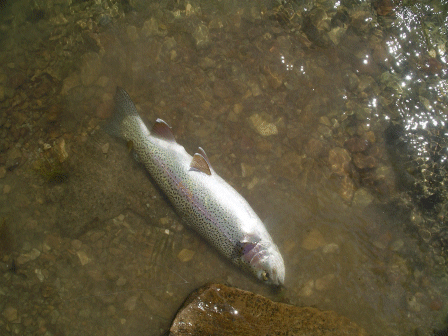
I followed her upstream through the cooler water and did finally land one decent fish - a rainbow of probably fifteen inches.
As it was only about six o'clock in the evening when we drove by Paradise Park - and as the temperature had been reading 103 on the Hotchkiss bank thermometer when we went through that town, we rigged up again, crossed the North Fork at the main stem confluence and hiked a mile or so upstream to try our hand at the shallow bank water.
Unhappily the downstream wind was also shrieking due to a nearby thunderstorm so casting was difficult at best and generally impossible. The shallow water dwelling browns were cooperative, but it was so tough to see the fly that we both missed nearly all of the 20-30 strikes we had before getting off the stream.
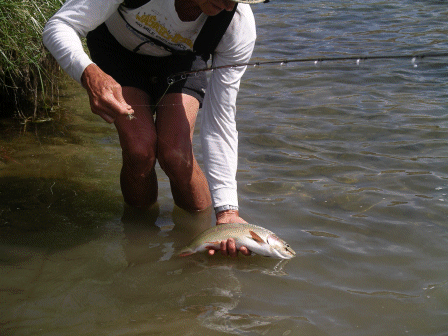 Next morning we
started the long hot hike up four miles or so. The lower stretch of the
Gunnison is kind of tough to figure out. We nymphed, surface fished, and
generally were confused for the first hour of the walk. Out of desperation
I eventually tied on a grasshopper and very quickly had a good sized rainbow on
the end. We kept playing with variations of either a nymph or smaller dry
as a companion fly and both of us played some decent fish during the rest of the
day.
Next morning we
started the long hot hike up four miles or so. The lower stretch of the
Gunnison is kind of tough to figure out. We nymphed, surface fished, and
generally were confused for the first hour of the walk. Out of desperation
I eventually tied on a grasshopper and very quickly had a good sized rainbow on
the end. We kept playing with variations of either a nymph or smaller dry
as a companion fly and both of us played some decent fish during the rest of the
day.
At one nice riffle about three miles into our hike I did land a pretty bow that took a small black stone trailing the hopper. Then upstream a bit further landed another nice female rainbow that took the single feather stone as it was being retrieved like a wooly bugger.
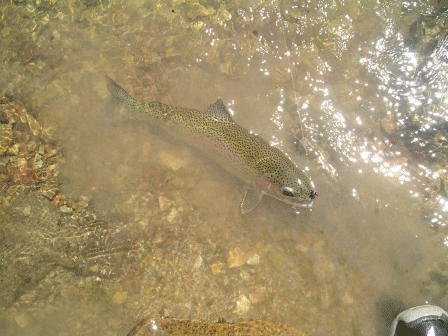
We continued to have decent numbers of strikes and fish played over the next couple of hours until we were driven from the water by the sweltering temperatures, but both Sue & I didn't release many. For some reason our last couple of trips have resulted in lots of fish on, but few to hand. Under most conditions that's fine, although once in while we do like to at least get some practice with our forceps.
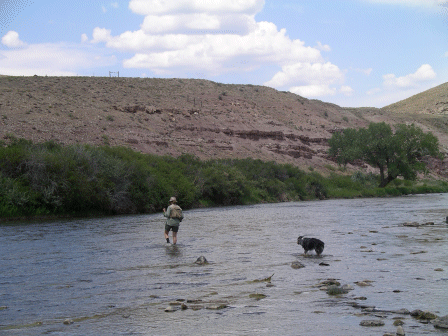 Crossed the North
Fork and decided to forego any more casting this weekend. Weather was just
too demoralizingly hot. As it turned out, that probably was a good
decision. The remnants of Hurricane Emily passed through over night
dumping tons of rain in the mountains and muddying every stream in sight.
Crossed the North
Fork and decided to forego any more casting this weekend. Weather was just
too demoralizingly hot. As it turned out, that probably was a good
decision. The remnants of Hurricane Emily passed through over night
dumping tons of rain in the mountains and muddying every stream in sight.
Last Logbook Entry � for previous days.
7/25-26: Gore Creek's running at an almost perfect flow right now. Despite that fact my efforts on the stream in the village yesterday evening were pretty lousy. By the time I figured out that I needed to go smaller, the wade was almost over. The first four hundred yards of casting had yielded but a single strike on a small unweighted prince. My #16 WRS was completely ignored. Changed to a #18 more sparsely tied WRS and had a few more strikes, but I only played a handful of fish this evening.
Today was a bit better. With the passage of a small cold front, air temperatures have cooled & even with cloudless skies, the fish seemed less skittish today. Went out to a fairly lightly fished area of the golf course and had very decent success although the strikes were lightning fast due to clear skies. Almost every piece of identifiable holding water brought one or more fish to the surface fly. They completely ignored the trailing #20 bead head buckskin, which I found very unusual.
Managed to play a good dozen & a half mostly smaller fish of three species - cutthroat excepted. Best of each were a fourteen inch brown, twelve inch rainbow, and ten inch brook. Hope to try another part of the creek tomorrow.
Home, Main Fishing Page, , Eagle River Access, Local Ten Commandments, Successful Fly Patterns